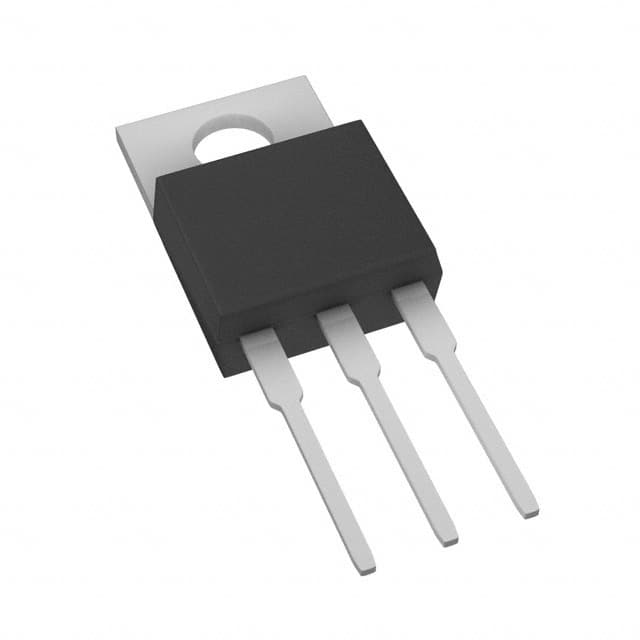Xem thông số kỹ thuật để biết chi tiết sản phẩm.

MBR30H50CTHE3/45
Introduction
The MBR30H50CTHE3/45 is a high-performance Schottky rectifier designed for use in various electronic applications. This entry provides an overview of the product, including its category, use, characteristics, package, essence, packaging/quantity, specifications, detailed pin configuration, functional features, advantages and disadvantages, working principles, detailed application field plans, and alternative models.
Product Overview
- Category: Electronic Components
- Use: Rectification in power supply circuits
- Characteristics: High efficiency, low forward voltage drop, fast switching speed
- Package: TO-220AB
- Essence: Schottky rectifier diode
- Packaging/Quantity: Tape & Reel, 800 units per reel
Specifications
- Voltage Rating: 50V
- Current Rating: 30A
- Forward Voltage Drop: 0.55V at 15A
- Reverse Leakage Current: 10μA at 25°C
- Operating Temperature Range: -65°C to 175°C
Detailed Pin Configuration
The MBR30H50CTHE3/45 follows the standard pin configuration for a TO-220AB package: 1. Anode 2. Cathode 3. Cathode
Functional Features
- High current capability
- Low power loss
- High efficiency
- Fast switching speed
- Guard ring for enhanced ruggedness and long-term reliability
Advantages and Disadvantages
Advantages
- Low forward voltage drop
- High current rating
- Wide operating temperature range
- Enhanced ruggedness
Disadvantages
- Relatively large package size
- Higher cost compared to standard rectifiers
Working Principles
The MBR30H50CTHE3/45 operates based on the Schottky barrier principle, where the metal-semiconductor junction allows for faster switching and lower forward voltage drop compared to conventional PN-junction diodes. When a forward bias is applied, the Schottky diode conducts current with minimal voltage drop, making it suitable for high-efficiency rectification applications.
Detailed Application Field Plans
The MBR30H50CTHE3/45 is commonly used in the following applications: - Switching power supplies - DC-DC converters - Inverters - Battery chargers - Motor drives - Solar panel bypass diodes
Detailed and Complete Alternative Models
For users seeking alternative models, the following Schottky rectifiers can be considered: - MBR20H100CT - MBRF20100CT - MBRB20100CT - MBRB2045CT - MBRB2060CT
In summary, the MBR30H50CTHE3/45 is a high-performance Schottky rectifier offering high current capability, low forward voltage drop, and fast switching speed. Its wide range of applications and availability of alternative models make it a versatile choice for various electronic designs.
Word count: 411
Liệt kê 10 câu hỏi và câu trả lời thường gặp liên quan đến ứng dụng MBR30H50CTHE3/45 trong giải pháp kỹ thuật
What is MBR30H50CTHE3/45?
- MBR30H50CTHE3/45 is a high-efficiency, fast-recovery rectifier diode designed for use in power supply and other applications.
What is the maximum voltage rating of MBR30H50CTHE3/45?
- The maximum voltage rating of MBR30H50CTHE3/45 is 50 volts.
What is the maximum current rating of MBR30H50CTHE3/45?
- The maximum current rating of MBR30H50CTHE3/45 is 30 amperes.
What are the typical applications of MBR30H50CTHE3/45?
- MBR30H50CTHE3/45 is commonly used in switch-mode power supplies, freewheeling diodes, and reverse battery protection.
What is the forward voltage drop of MBR30H50CTHE3/45 at its rated current?
- The forward voltage drop of MBR30H50CTHE3/45 at its rated current is typically around 0.65 volts.
Is MBR30H50CTHE3/45 suitable for high-frequency switching applications?
- Yes, MBR30H50CTHE3/45 is designed for high-frequency switching applications due to its fast-recovery characteristics.
Does MBR30H50CTHE3/45 have a low leakage current?
- Yes, MBR30H50CTHE3/45 exhibits low leakage current, making it suitable for low-power standby mode applications.
What is the operating temperature range of MBR30H50CTHE3/45?
- MBR30H50CTHE3/45 is designed to operate within a temperature range of -55°C to 175°C.
Can MBR30H50CTHE3/45 be used in automotive electronics applications?
- Yes, MBR30H50CTHE3/45 is suitable for automotive electronics applications due to its rugged construction and high reliability.
Are there any recommended layout considerations for using MBR30H50CTHE3/45 in a circuit?
- It is recommended to minimize the length of the traces connecting MBR30H50CTHE3/45 to reduce parasitic inductance and ensure proper thermal management for optimal performance.

